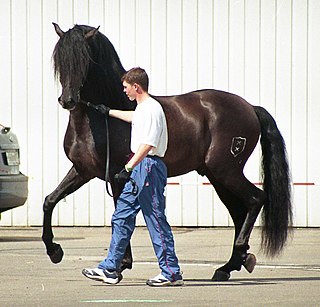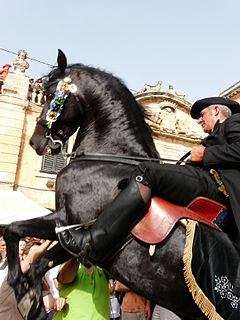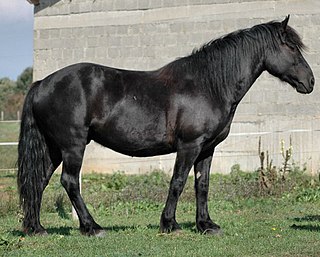 W
WThe Andalusian, also known as the Pure Spanish Horse or PRE, is a horse breed from the Iberian Peninsula, where its ancestors have lived for thousands of years. The Andalusian has been recognized as a distinct breed since the 15th century, and its conformation has changed very little over the centuries. Throughout its history, it has been known for its prowess as a war horse, and was prized by the nobility. The breed was used as a tool of diplomacy by the Spanish government, and kings across Europe rode and owned Spanish horses. During the 19th century, warfare, disease and crossbreeding reduced herd numbers dramatically, and despite some recovery in the late 19th century, the trend continued into the early 20th century. Exports of Andalusians from Spain were restricted until the 1960s, but the breed has since spread throughout the world, despite their low population. In 2010, there were more than 185,000 registered Andalusians worldwide.
 W
WThe Asturcón is an ancient breed of small horse or pony from the autonomous region of Asturias in northern Spain. It has been documented since Roman times: it has an unusual ambling gait, which was described by Pliny the Elder in his Naturalis Historia. It is of Celtic type, and shows similarity to the Pottok and Losino of Spain, the Garrano of Portugal, and the Dartmoor, Exmoor, Fell, Highland, Shetland and Welsh breeds of the British Isles.
 W
WThe Burguete horse is a breed of horse from the Navarre region of northern Spain. It is listed in the Catálogo Oficial de Razas de Ganado de España in the group of autochthonous breeds in danger of extinction.
 W
WThe Galician or Galician Mountain Horse, Spanish: Caballo de Pura Raza Gallega, Galician: Raza Equina Cabalo Galego do Monte, is a breed of small horse from Galicia, in north-western Spain. It is genetically very close to the Garrano breed of northern Portugal. It was in the past used as a war-horse and in agriculture; it is now raised principally for meat. The horses are bay or black.
 W
WThe Hispano-Árabe is a Spanish horse breed originating from the cross-breeding of Arab and Andalusian horses.
 W
WThe Hispano-Bretón is a Spanish breed of horse developed by crossing native Pura Raza Española horses with imported Breton draught horses. The breed is found mainly in two separate areas of northern Spain: Castile and León and parts of neighboring Cantabria; and the Pyrenees of Catalonia. The Hispano-Bretón is listed in the Catálogo Oficial de Razas de Ganado de España in the group of autochthonous breeds in danger of extinction. The scientific work titled “Morphological and genetic characterization of Spanish heavy horse breeds: Implications for their conservation” was written by M.D. Gómez, P.J. Azor, M.E. Alonso, J. Jordana, and M. Valera. The already introduced scientific paper suggests that the ecologically important rural areas in Spain have been conserved by the Spanish heavy horses and one of such breeds is the Hispano-Breton heavy horse breed. The creation of the Hispano-Breton breed was the result of the Spanish Military Cavalry services using Spanish Breton stallions, which have been regularly produced from the Spanish draught horse populations since the 1960s. Similarly, the increase in the body size of the Native Spanish horse breeds was led by the interest in obtaining draught horses for agricultural and military purposes. Towards the end of the 20th century, the technological advancements at that point in time led to a dramatic decrease in the Spanish heavy horse population and some of those horse populations disappeared while others were used to produce horse meat. Consequently, the Spanish government has considered the Hispano-Breton heavy horse breed as an endangered breed alongside with both the Jaca Navarra and the Burguete horse breeds. The three Spanish heavy horse breeds just mentioned, as the study suggests, “make up about 90% of the total number of horses slaughtered in Spain nowadays.” The north of Castilla-Leon in Spain, usually the south side of the Cantabrian mountain range, is where the Hispano-Breton breed is located today. The Hispano-Breton breed was officially recognized in 1960 while the breed's stud book was set in 1998. It has been reported that there are 6307 animals from this breed. As the study suggests, “the main problems are the small population size and genetic degeneration, with the consequent future loss of diversity. Therefore, the most immediate and effective conservation priorities would be (1) to avoid inbreeding within populations, (2) to increase the population size, and (3) to facilitate genetic exchange among the populations.” The already mentioned study was conducted to learn how to save the Hispano-Breton endangered sub-breeds alongside other Spanish heavy horse breeds. And it determined that the Hispano-Breton from Castilla-Leon, Spain displayed the highest average of measurements for, as listed in the study, “the traits related to body width: depth, width and perimeter of thorax, width of chest, body length and cannon perimeter.” The study required a total of 426 horses from six Spanish heavy horse populations, which, as the study states, “[correspond] to the four main heavy horse breeds Hispano-Breton … with most animals located in three areas: Burgos, León, and Palencia … Jaca Navarra, Burguete and the Cavall Pirinenc Català were analyzed using 22 body measurements, 10 indices calculated from the body measurements and 16 microsatellite markers.” It is important to mention that in the previously mentioned study concluded that the Hispano-Breton breeds from both Burgos, Spain and from Palencia, Spain accounted for the Spanish heavy breeds with the lowest body indices related to meat production in both males and females. This study also concluded that the Hispano-Breton breed from Castilla-Leon, Spain has a great body size difference from the other Spanish heavy horse breeds analyzed during this study. However, these breeds also showed the highest body indices for meat production. And lastly, the Hispano-Breton heavy horse breed from Castilla-Leon, Spain has received economic funding to express its genetic background since it has been considered the subpopulation of heavy horse breeds that represents the Hispano-Breton heavy horse breed the most.
 W
WThe Jaca Navarra, or Navarrese Horse, is a breed of small horse from the Navarre region of northern Spain. It is listed in the Catálogo Oficial de Razas de Ganado de España in the group of autochthonous breeds in danger of extinction. The total population of the Jaca Navarra has been variously estimated at 350, 250, and 240 and decreasing. In April 2011 the total population was reported to be 899, all of which were in Navarre. The breed is listed by the FAO as Endangered.
 W
WThis is a list of the breeds of horse considered in Portugal and Spain to have originated wholly or partly in those countries. Inclusion here does not necessarily imply that a breed is predominantly or exclusively of Iberian origin.
 W
WThe Caballo Losino or Caballo de Raza Losina is a breed of horse from the Valle de Losa in the province of Burgos, in Castile and León in northern Spain. This breed is one of three breeds indigenous to the Iberia Peninsula. "They live at “an altitude from 600 to 1,450 m its breeding system develop under adverse conditions because of hard climate' ". It is listed in the Catálogo Official de Razas de Ganado de España in the group of autochthonous breeds in danger of extinction.
 W
WThe Mallorquín or Caballo Mallorquín is a rare breed of horse indigenous to the island of Mallorca in the Balearic Islands, from which it takes its name. Identification of the breed was begun in 1981 by the Patronato para las Razas Autóctonas de Mallorca. The Mallorquín is listed in the Catálogo Oficial de Razas de Ganado de España in the group of autochthonous breeds in danger of extinction.
 W
WThe Marismeño is a rare breed of horse indigenous to the marshes of the Guadalquivir River, from which it takes its name. It is now found particularly in the Doñana National Park, which lies mostly in the province of Huelva, in Andalusia, southwestern Spain. Until recently it was not considered a breed; recognition and recovery began in 2003. It is listed in the Catálogo Oficial de Razas de Ganado de España in the group of autochthonous breeds in danger of extinction.
 W
WThe Menorquín or Catalan: Cavall Menorquí is a breed of horse indigenous to the island of Menorca in the Balearic Islands, from which it takes its name. It is closely associated with the doma menorquina style of riding.
 W
WThe Mérens, Cheval de Mérens or Caballo de Merens, still occasionally referred to by the older name of Ariégeois pony, is a small, rustic horse native to the Pyrenees and Ariégeois mountains of southern France, where the Ariège River flows, and northern Spain, near Andorra. Two general types, a small, light traditional mountain horse and a taller, sportier modern type, are found. Always black in color, Mérens must meet strict physical standards in order to be registered in the stud book. The breed is known for its sure-footedness on mountain terrain, as well as for its endurance, hardiness and docility. The French breed registry organizes regional offices, and partners with other national organizations in Europe to preserve and promote the breed. The organization enforces rigorous selection of breeding stock, with a goal of increasing quality in the breed. In the past, the Mérens was used for farm work, draft work and as pack horses. Today it is mainly used as a saddle horse, although some members of the breed have been successful in carriage driving. Many Mérens are taken on an annual transhumance, in which they are moved higher in the mountains during the summer and into the valleys for the winter. An old practice, it fell into disfavor, but has recently re-emerged.
 W
WThe Monchino or Monchinu or is a breed of horse indigenous to the Valle de Guriezo in the Cantabria region of northern Spain, and also extending into neighbouring Biscay province. It is listed in the Official Catalogue of Livestock Breeds of Spain in the group of autochthonous breeds in danger of extinction. The word monchinu means highlander, from the mountains, in Cantabrian.
 W
WThe Pottok or Pottoka, is an endangered, semi-feral breed of pony native to the Pyrenees of the Basque Country in France and Spain.